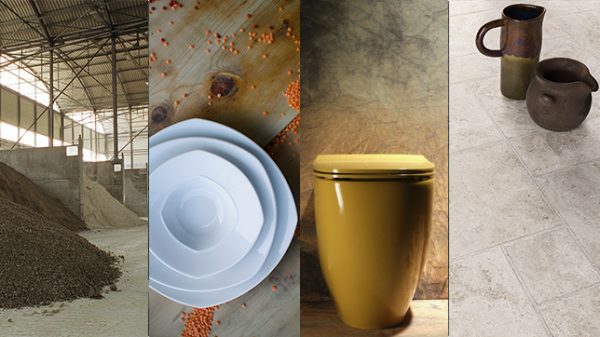Italian ceramic industry demonstrates how tradition and innovation can coexist in a sustainable and competitive development model
The collection of industrial symbiosis best practices published by the INSET project working group shows how various sectors – from agri-food to manufacturing – are transforming their production models toward closed-loop systems. Among these, the experiences of the Italian ceramic sector stand out with particular prominence, having completely reinvented its approach to sustainability.
The ceramic sector cluster in Emilia-Romagna represents a concrete example of Industrial Symbiosis application, enabling the territorial system to remain competitive while optimizing the use of materials and by-products.
What was once considered a high environmental impact sector has transformed into a virtuous model where, in 2024, 11.2% of raw material needs were covered using recycled materials and 48% of water requirements were met through wastewater reuse (Confindustria Ceramica data, 2024). This transformation didn’t happen by chance but through structural investments: the ceramic tile sector reinvests an average of 8-10% of turnover in research and development (source: Confindustria Ceramica).
The Strategic Role of Confindustria Ceramica
In this context of territorial awareness-raising and innovation, Confindustria Ceramica plays a strategic role. At the European level, the 2024-2029 Manifesto of Cerame-Unie outlines sector priorities for the new legislative term, emphasizing the need for policies that consider social and economic sustainability in the decarbonization pathway.
Confindustria Ceramica has played a key role in this transition, supporting companies in adopting “closed-loop” logic. The Association has promoted since 2016 the development of a sectoral Environmental Product Declaration (EPD), updated in 2024 based on data from over 87 production sites representing 82% of Italian production (source: interview with Simone Mosconi, Confindustria Ceramica).
The strategy operates on multiple levels:
- Intra-company recovery: valorization of waste, ceramic sludge, hot fumes from kilns
- Inter-company symbiosis: exchange of “atomized” materials between full-cycle and partial-cycle companies
- Process innovation: water treatment and recycling systems for industrial water
A Collaborative Management Model
The ceramic district experience demonstrates the importance of multi-stakeholder dialogue for industrial symbiosis success. The established collaboration between Confindustria Ceramica, Emilia-Romagna Region, ACIMAC (Italian Association of Ceramic Machinery Manufacturers) and trade union organizations has created a regulatory and operational framework that facilitates resource and expertise exchange.
This collaborative model has also led to the definition of four specific types of ceramic by-products, enabling the recovery of approximately 25,000 tons annually of materials that would otherwise have been disposed of as waste (Emilia-Romagna Region data, source: Confindustria Ceramica interview).
Training and Skills for the Future
The success of industrial symbiosis requires specific competencies in managing and designing these initiatives. INSET offers free training programs for Industrial Symbiosis Managers and Planners, developed according to European VET training quality principles.
The role of Confindustria Ceramica highlights how crucial qualified facilitators are in overcoming cultural and regulatory barriers that often hinder the implementation of industrial symbiosis projects.
Future Perspectives
The ceramic district is already looking beyond its sectoral boundaries, experimenting with materials from glass recycling collection and recovery of decommissioned sanitary ware. Research projects in collaboration with universities are evaluating the integration of increasing quotas of recycled materials in ceramic formulations.
As Simone Mosconi from Confindustria Ceramica emphasizes: “The need to contain waste by valorizing by-products, including those from other sectors, will be a challenge affecting the entire European production context.”
The experience of the Emilian ceramic district demonstrates that industrial symbiosis is not just an environmental strategy, but a true driver of economic competitiveness and technological innovation.
Sources:
Confindustria Ceramica production data (2024)
Cerame-Unie 2024-2029 Manifesto
Emilia-Romagna Regional Law No. 16/2015 on by-products
For more details on INSET training programs and industrial symbiosis best practices, visit our website and discover how to transform your production processes into sustainable growth opportunities.
